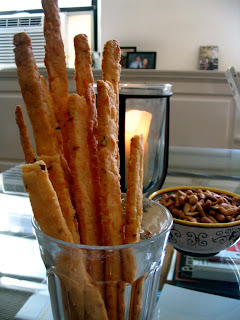 The guys over at Baked are the first to admit their Sour Cream Coffee Cake with Chocolate Cinnamon Swirl is "not the most nutritious breakfast." If that's what you're after, I suggest granola or a homemade power bar. But if you want a real treat--coffee cake and crumb topping in the perfect ratio of moist cake to crumbly topping--keep reading.
The guys over at Baked are the first to admit their Sour Cream Coffee Cake with Chocolate Cinnamon Swirl is "not the most nutritious breakfast." If that's what you're after, I suggest granola or a homemade power bar. But if you want a real treat--coffee cake and crumb topping in the perfect ratio of moist cake to crumbly topping--keep reading.This coffee cake is a keeper. It's pretty classic, with its batter made with sour cream, and its crumb topping a mix of brown sugar and nuts. But then there are these tasty in-between layers of chocolate and cinnamon. I love a healthy breakfast as much as the next person, but there is nothing like a delicious piece of coffee cake with a cup of coffee on a winter morning. And 'tis the season, right?
A few notes: I used walnuts in the crumb topping, instead of the suggested pecans. This wasn't a problem. And spreading the batter over the cinnamon swirl is a little tricky. Just do what you can; using a small offset spatula helps. Finally, the recipe suggests you do not substitute low-fat sour cream or yogurt to reduce calories. I absolutely agree.
If you've got family coming into town for the holidays, or a brunch party coming up, or if you're just sick of good-for-you-breakfasts, now's the time. Sour Cream Coffee Cake is calling your name.--S
Sour Cream Coffee Cake with Chocolate Cinnamon Swirl
Serves 16
Crumb Topping
3/4 c all-purpose flour
3/4 c packed dark brown sugar
1/2 t salt
3/4 c pecans [or walnuts, or other nuts], toasted
6 T cold unsalted butter, cut into 1" pieces
Chocolate Cinnamon Swirl
1/2 c sugar
1 t dark unsweetened cocoa powder
1 1/2 t cinnamon
Cake
3 1/2 cups all-purpose flour
1 t baking powder
1 1/2 t baking soda
1/2 t salt
2 sticks unsalted butter, softened
2 1/4 c sugar
4 large eggs
16 oz sour cream
1 1/2 t pure vanilla extract
Crumb Topping:
Put the flour, sugar, and salt in bowl of food processor and pulse to combine. Add the pecans and pulse until they are finely chopped and incorporated. Add the butter and pulse until mixture looks like coarse sand. Cover and refrigerate.
Chocolate Cinnamon Swirl:
Mix ingredients in small bowl.
Sour Cream Cake:
1. Preheat the oven to 350° F. Butter a 9×13-inch baking pan. Sift together the flour, baking powder, baking soda, and salt together in a medium bowl.
2. In the bowl of a stand mixer fitted with the paddle attachment, cream the butter until smooth. Scrape down bowl and add sugar. Beat until the mixture is light and fluffy. Add the eggs, one at a time, beating well after each addition and scraping bowl as needed.
3. Add the sour cream and vanilla and beat just until incorporated. Add the dry ingredients in three additions, scraping down the bowl before each addition and beating only until each addition is just incorporated. Do not overmix.
4. Pour one third of the cake batter into the prepared pan. Use an offset spatula to spread batter evenly in pan. Sprinkle half of the chocolate cinnamon swirl mixture over batter, covering the entire surface of the batter. Spoon half of remaining batter over the swirl mixture and spread it evenly. Top with remaining swirl mixture, then the remaining batter, and spread the batter evenly. Sprinkle the crumb topping evenly over the top of the batter.
5. Bake in the center of the oven for one hour, or until a toothpick inserted in the center of the cake comes out clean. Let the cake cool on a wire rack for 30 minutes.
The cake keeps for a few days, tightly covered, at room temperature.









































